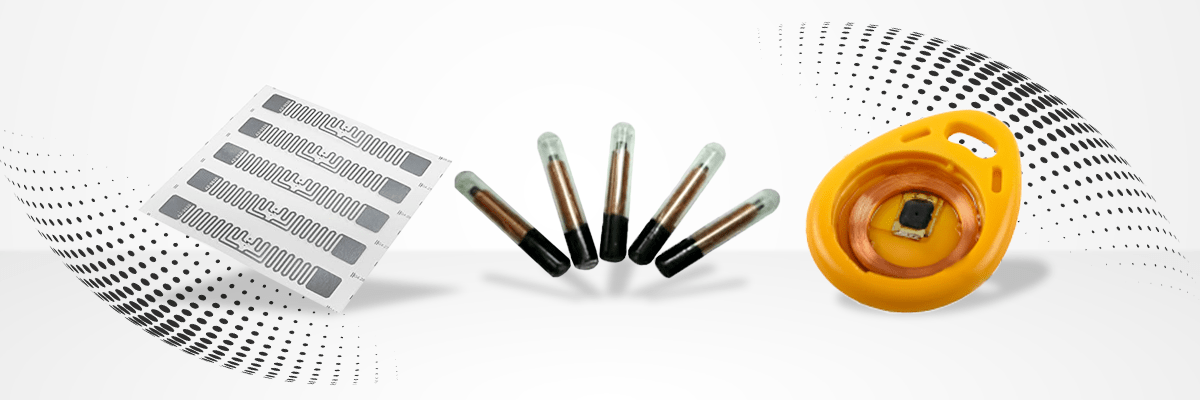LF RFID Tag Design and Components
Low Frequency (LF) RFID tags, typically operating at 125 kHz or 134.2 kHz, are integral to various industries for tracking, identification, and authentication. The design of an LF RFID tag consists of several key components: a microchip, an antenna, and encapsulating material. The microchip is the core of the tag, storing a unique identifier or data, and is responsible for modulating the electromagnetic signal received from an LF RFID reader. The antenna, usually a copper coil, generates the necessary inductive coupling to communicate with the reader, allowing energy transfer and data exchange. These components are often enclosed in durable materials such as epoxy, plastic, or glass to protect them from environmental damage, making LF RFID tags suitable for harsh environments like industrial settings or animal tracking.
Mechanically, the tag’s structure must ensure both durability and efficient signal transmission. The encapsulating material provides protection against moisture, dust, and mechanical stress, while also ensuring the antenna is properly aligned to maximize the tag’s reading range. The size and shape of the tag vary depending on the application, with some designed to be affixed to assets, embedded in products, or even implanted into animals for identification purposes.
The software aspect of an LF RFID tag includes the unique encoding of data on the microchip, which follows industry-specific protocols. These tags usually comply with ISO 11784 and ISO 11785 standards, which govern animal identification and other LF RFID applications. The tags are passive, meaning they rely entirely on the energy transmitted by the reader to function, eliminating the need for an internal power source.
Working Principles and Internal Components
The operation of LF RFID tags is based on inductive coupling. When an LF RFID reader generates an electromagnetic field, the tag’s antenna absorbs this energy, which powers the microchip. Once powered, the tag modulates this field to send data back to the reader. The microchip in an LF RFID tag typically consists of a read-only memory (ROM) where the unique ID or data is stored. In some cases, more advanced tags might include rewritable memory that can be updated by the reader.
One internal component commonly found in LF RFID tags is a copper wire coil serving as the antenna, which is crucial for both capturing the reader’s signal and transmitting data. Another example is a silicon-based microcontroller that processes the communication between the tag and reader, ensuring efficient data exchange.
Connections and Interfaces
LF RFID tags are often used in systems where they communicate with LF RFID readers via inductive coupling. These tags do not have physical ports or interfaces for direct connection with other devices. Instead, they rely entirely on wireless communication protocols to exchange data. Tags are frequently integrated into larger systems, such as asset tracking networks, through the readers that capture their data and relay it to a centralized system or database. This integration is typically managed through protocols like RS232, TCP/IP, or wireless interfaces that readers use to communicate with backend systems.
Industry Standards and Regulatory Compliance
LF RFID tags, especially in applications like animal identification or industrial asset tracking, must adhere to strict industry standards. ISO 11784 and ISO 11785 are key international standards for LF RFID tags, particularly in animal tracking and livestock management. These standards ensure compatibility and performance across systems, guaranteeing that tags and readers from different manufacturers can operate seamlessly together.
In the United States, LF RFID tags must comply with the Federal Communications Commission (FCC) Part 15 regulations, which govern electromagnetic emissions to prevent interference with other wireless communications. In Canada, tags must meet Industry Canada (IC) regulations, which set similar guidelines for radio frequency devices. Both countries also have specific regulations for RFID tags used in animal identification and tracking, ensuring that these devices are safe, reliable, and environmentally sustainable.
GAO RFID ensures that all LF RFID tags are compliant with both U.S. and Canadian regulations, undergoing rigorous quality assurance and testing to ensure high performance and reliability. Each tag is tested for durability, signal strength, and environmental resilience, guaranteeing that they meet the needs of demanding industrial and agricultural applications.
Quality Assurance and Testing
GAO RFID Inc. follows a stringent quality assurance process to guarantee the durability and performance of our LF RFID tags. Each tag is tested in simulated real-world conditions, such as extreme temperatures, moisture, and physical impacts, to ensure long-term reliability. Signal range tests are conducted to verify the effectiveness of the antenna design and to ensure that the tags can be read from the appropriate distances. The testing process also includes electromagnetic compatibility (EMC) tests to ensure that the tags operate without causing interference with other wireless systems, making them suitable for environments with high levels of electronic noise.
Our products are in stock and can be shipped overnight to Continental U.S. and Canada from one of our local warehouses. If you have any questions, our technical experts can help you. Please fill out this form or email us.

